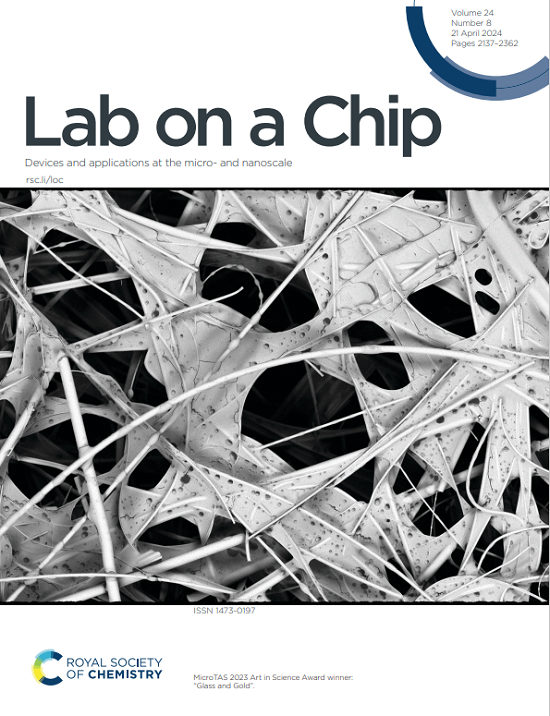Microengineered Diabetic Wound-on-a-Chip Model for Emulating Chronic Wound Dynamics
IF 5.4
2区 工程技术
Q1 BIOCHEMICAL RESEARCH METHODS
引用次数: 0
Abstract
Diabetic wounds, which affect 19–34% of individuals with Diabetes Mellitus, remain a serious complication due to their chronic, non-healing nature and high risk of limb amputation. Traditional 2D in vitro systems and animal models often fail to replicate the intricate cellular interactions and microenvironmental complexity of human diabetic wounds. To address this gap, a humanized 3D diabetic wound-on-a-chip (DWOC) model was developed to simulate key aspects of diabetic wound pathology under physiologically relevant conditions. This four-channel microfluidic platform integrates human dermal fibroblasts and macrophages within a collagen I matrix to mimic the dermis, alongside endothelial cells embedded in Matrigel to represent the vascular compartment. The system was subjected to hyperglycemic conditions with added advanced glycation end-products (AGEs) and lipopolysaccharide (LPS), alongside normoglycemic controls. Cellular viability, extracellular matrix (ECM) remodeling, myofibroblast differentiation, angiogenesis, and intercellular signaling were assessed using immunofluorescence markers (CD68, α-SMA, CD31, VE-cadherin, SLUG). Cytokine profiling (ELISA, multiplex assays) evaluated inflammatory responses. The DWOC effectively replicated hallmarks of diabetic wound pathology, including impaired ECM remodeling, disrupted dermal–vascular cell crosstalk, defective angiogenesis, and signs of Endothelial-to-Mesenchymal Transition (EndMT) in endothelial cells under diabetic stress. Elevated pro-inflammatory markers (IL-1β, TNF-α, MMP9) and reduced anti-inflammatory/angiogenic factors (IL-10, VEGF-A) reflected the chronic inflammatory and angiogenic imbalance characteristic of non-healing diabetic ulcers. This advanced DWOC platform offers a physiologically relevant, human-specific model for studying diabetic wound healing, highlighting Endothelial-to-Mesenchymal Transition as a critical pathological feature and enabling preclinical evaluation of targeted therapies.微工程糖尿病伤口芯片模型模拟慢性伤口动力学
糖尿病伤口影响了19-34%的糖尿病患者,由于其慢性、不愈合和截肢的高风险,仍然是一个严重的并发症。传统的二维体外系统和动物模型往往无法复制复杂的细胞相互作用和人类糖尿病伤口的微环境复杂性。为了解决这一空白,开发了一种人性化的3D糖尿病伤口芯片(DWOC)模型,以模拟生理相关条件下糖尿病伤口病理的关键方面。这种四通道微流控平台将人类真皮成纤维细胞和巨噬细胞整合在胶原I基质中以模拟真皮,并将内皮细胞嵌入在Matrigel中以代表血管室。该系统在正常血糖控制的同时,添加了晚期糖基化终产物(AGEs)和脂多糖(LPS),使其处于高血糖状态。使用免疫荧光标记(CD68、α-SMA、CD31、VE-cadherin、SLUG)评估细胞活力、细胞外基质(ECM)重塑、肌成纤维细胞分化、血管生成和细胞间信号传导。细胞因子分析(ELISA,多重检测)评估炎症反应。DWOC有效地复制了糖尿病伤口病理的特征,包括糖尿病应激下内皮细胞的ECM重塑受损、真皮-血管细胞串扰中断、血管生成缺陷以及内皮细胞向间质转化(EndMT)的迹象。促炎标志物(IL-1β、TNF-α、MMP9)升高和抗炎/血管生成因子(IL-10、VEGF-A)降低反映了未愈合的糖尿病溃疡慢性炎症和血管生成失衡的特征。这个先进的DWOC平台为研究糖尿病伤口愈合提供了一个生理学相关的、人类特异性的模型,强调内皮到间充质转化是一个关键的病理特征,并使靶向治疗的临床前评估成为可能。
本文章由计算机程序翻译,如有差异,请以英文原文为准。
求助全文
约1分钟内获得全文
求助全文
来源期刊

Lab on a Chip
工程技术-化学综合
CiteScore
11.10
自引率
8.20%
发文量
434
审稿时长
2.6 months
期刊介绍:
Lab on a Chip is the premiere journal that publishes cutting-edge research in the field of miniaturization. By their very nature, microfluidic/nanofluidic/miniaturized systems are at the intersection of disciplines, spanning fundamental research to high-end application, which is reflected by the broad readership of the journal. Lab on a Chip publishes two types of papers on original research: full-length research papers and communications. Papers should demonstrate innovations, which can come from technical advancements or applications addressing pressing needs in globally important areas. The journal also publishes Comments, Reviews, and Perspectives.
 求助内容:
求助内容: 应助结果提醒方式:
应助结果提醒方式:


